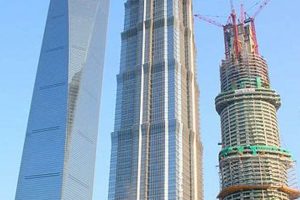A skyscraper is a continuously habitable high-rise building that has over 40 stories or is taller than 150 meters (492 feet). Skyscrapers are often used for commercial purposes, such as offices, hotels, and apartments. The first skyscraper was the Home Insurance Building in Chicago, which was completed in 1885 and had 10 stories.
Skyscrapers have become increasingly popular in recent years, as they offer a number of advantages over other types of buildings. For example, skyscrapers can accommodate a large number of people in a relatively small amount of space, which can be beneficial in densely populated areas. Additionally, skyscrapers can provide panoramic views of the surrounding area, which can be a valuable amenity for both residents and businesses.
However, there are also some challenges associated with skyscrapers. For example, skyscrapers can be expensive to construct and maintain, and they can be difficult to evacuate in the event of a fire or other emergency. Additionally, skyscrapers can cast shadows on nearby buildings and streets, which can be a nuisance for pedestrians and motorists.
1. Height
Height is one of the most important factors that classifies a skyscraper. The Council on Tall Buildings and Urban Habitat (CTBUH) defines a skyscraper as a building that is at least 150 meters (492 feet) tall. However, some buildings that are shorter than 150 meters may still be considered skyscrapers if they have a large number of stories or a particularly distinctive design.
There are a number of reasons why height is such an important factor in classifying a skyscraper. First, height is a measure of a building’s prominence and grandeur. A tall building can be seen from a great distance and can dominate a city’s skyline. Second, height is a measure of a building’s engineering prowess. Constructing a tall building requires a great deal of skill and expertise, and it is a testament to the abilities of the architects and engineers who design and build these structures.
Some of the tallest buildings in the world include the Burj Khalifa in Dubai, the Shanghai Tower in China, and the One World Trade Center in New York City. These buildings are all over 500 meters tall and are marvels of modern engineering. They are also symbols of the economic and technological power of the cities in which they are located.
2. Stories
The number of stories in a building is another important factor that classifies a skyscraper. The CTBUH defines a story as a space within a building that is at least 3 meters (9.8 feet) high and is used for human occupancy. Buildings with a large number of stories are often considered to be skyscrapers, even if they are not particularly tall. For example, the Burj Khalifa has 163 stories, but it is only 828 meters (2,717 feet) tall. In contrast, the Shanghai Tower has 128 stories, but it is 632 meters (2,073 feet) tall.
There are a number of reasons why the number of stories is an important factor in classifying a skyscraper. First, the number of stories is a measure of a building’s capacity. A building with a large number of stories can accommodate more people and businesses than a building with a small number of stories. Second, the number of stories is a measure of a building’s complexity. A building with a large number of stories requires more complex engineering and construction techniques than a building with a small number of stories.
The number of stories in a skyscraper can also affect its design. For example, buildings with a large number of stories often have a more slender design than buildings with a small number of stories. This is because slender buildings are more efficient at resisting wind loads. The Burj Khalifa, for example, has a very slender design, with a height-to-width ratio of 1:10. This allows it to withstand the high winds that are common in Dubai.
3. Purpose
The purpose of a building is another important factor that classifies a skyscraper. Skyscrapers are typically used for commercial purposes, such as offices, hotels, and apartments. However, some skyscrapers are also used for residential purposes, such as the Burj Khalifa. The purpose of a building can affect its design, height, and number of stories.
For example, office buildings are typically designed to be tall and slender, with a large number of stories. This allows them to accommodate a large number of workers in a relatively small amount of space. In contrast, residential buildings are typically designed to be shorter and wider, with a smaller number of stories. This allows them to provide more living space for residents.
The purpose of a building can also affect its height. For example, office buildings are often taller than residential buildings because they need to accommodate more workers. The Burj Khalifa, for example, is an office building that is over 828 meters (2,717 feet) tall. In contrast, the Shanghai Tower, which is a residential building, is only 632 meters (2,073 feet) tall.
Understanding the connection between purpose and what classifies a skyscraper is important for a number of reasons. First, it helps us to understand the different types of skyscrapers that exist and how they are used. Second, it helps us to appreciate the engineering challenges involved in designing and constructing skyscrapers. Third, it helps us to make informed decisions about how we use and develop our cities.
Design
The design of a skyscraper is another important factor that classifies it as a skyscraper. Skyscrapers are typically designed to be tall and slender, with a large number of stories. This allows them to accommodate a large number of people and businesses in a relatively small amount of space. However, the design of a skyscraper can vary depending on its purpose, location, and the materials used to construct it.
For example, office buildings are typically designed to be tall and slender, with a large number of stories. This allows them to accommodate a large number of workers in a relatively small amount of space. In contrast, residential buildings are typically designed to be shorter and wider, with a smaller number of stories. This allows them to provide more living space for residents.
The design of a skyscraper can also be affected by its location. For example, skyscrapers in earthquake-prone areas are often designed to be more resistant to earthquakes. Skyscrapers in windy areas are often designed to be more aerodynamic. Understanding the connection between design and what classifies a skyscraper is importa
nt for a number of reasons. First, it helps us to understand the different types of skyscrapers that exist and how they are used. Second, it helps us to appreciate the engineering challenges involved in designing and constructing skyscrapers. Third, it helps us to make informed decisions about how we use and develop our cities.
4. Location
The location of a skyscraper is an important factor that classifies it as a skyscraper. Skyscrapers are typically built in densely populated areas, where land is scarce and expensive. This is because skyscrapers can accommodate a large number of people and businesses in a relatively small amount of space. For example, the Burj Khalifa, the tallest building in the world, is located in Dubai, one of the most densely populated cities in the world.
The location of a skyscraper can also affect its design. For example, skyscrapers in earthquake-prone areas are often designed to be more resistant to earthquakes. Skyscrapers in windy areas are often designed to be more aerodynamic. The location of a skyscraper can also affect its purpose. For example, skyscrapers in financial districts are often used for office space, while skyscrapers in tourist areas are often used for hotels and apartments.
Understanding the connection between location and what classifies a skyscraper is important for a number of reasons. First, it helps us to understand the different types of skyscrapers that exist and how they are used. Second, it helps us to appreciate the engineering challenges involved in designing and constructing skyscrapers. Third, it helps us to make informed decisions about how we use and develop our cities.
5. Materials
The materials used to construct a skyscraper are an important factor that classifies it as a skyscraper. Skyscrapers are typically constructed using steel, concrete, and glass. These materials are strong and durable, and they can withstand the high winds and earthquakes that are common in many urban areas.
The choice of materials used to construct a skyscraper can also affect its design. For example, buildings constructed using steel are typically lighter and more flexible than buildings constructed using concrete. This makes them more resistant to earthquakes. Buildings constructed using glass are typically more transparent than buildings constructed using other materials. This allows them to let in more natural light and provide occupants with better views of the surrounding area.
Understanding the connection between materials and what classifies a skyscraper is important for a number of reasons. First, it helps us to understand the different types of skyscrapers that exist and how they are constructed. Second, it helps us to appreciate the engineering challenges involved in designing and constructing skyscrapers. Third, it helps us to make informed decisions about how we use and develop our cities.
6. Engineering
Engineering plays a critical role in defining what classifies a skyscraper by ensuring structural integrity, optimizing space, and enabling sustainable practices. Here are a few key facets:
- Structural Design
Engineering ensures skyscrapers can withstand various forces, including wind, earthquakes, and gravity. Structural designs involve complex calculations, innovative materials, and advanced construction techniques to create frameworks that can support immense weight and resist lateral forces.
- Space Optimization
Skyscrapers are designed to maximize vertical space utilization in densely populated areas. Engineers employ efficient floor plans, optimize elevator systems, and incorporate innovative space-saving solutions to create functional and comfortable environments within limited footprints.
- Vertical Transportation
Efficient vertical transportation is crucial in skyscrapers. Engineers design high-speed elevators, escalators, and sometimes even sky lobbies to facilitate seamless movement of occupants, optimizing circulation and minimizing wait times.
- Sustainability and Energy Efficiency
Modern engineering practices emphasize sustainability in skyscrapers. Engineers integrate energy-efficient systems, utilize renewable energy sources, and employ innovative materials to reduce environmental impact, promote occupant well-being, and achieve green building certifications.
These engineering facets are intricately intertwined, allowing skyscrapers to push architectural boundaries and redefine urban skylines. By understanding the engineering behind skyscrapers, we gain a deeper appreciation for their resilience, functionality, and impact on the built environment.
7. Sustainability
Sustainability has become an increasingly important factor in what classifies a skyscraper. As cities around the world grow denser and more populated, the need for sustainable buildings that can minimize their environmental impact and promote occupant well-being has become paramount.
Skyscrapers, with their massive scale and energy consumption, have a unique opportunity to lead the way in sustainability. By incorporating green building practices and technologies, architects and engineers can create skyscrapers that are not only iconic landmarks but also responsible stewards of the environment.
One of the most important aspects of sustainable skyscraper design is energy efficiency. Skyscrapers can consume vast amounts of energy for lighting, heating, cooling, and other operations. By using energy-efficient building materials, appliances, and systems, skyscrapers can significantly reduce their energy consumption and greenhouse gas emissions.
Another important aspect of sustainable skyscraper design is water conservation. Skyscrapers can use large amounts of water for irrigation, landscaping, and other purposes. By using water-efficient fixtures and appliances, and by capturing and reusing rainwater, skyscrapers can significantly reduce their water consumption.Finally, sustainable skyscraper design must also consider the health and well-being of occupants. Skyscrapers can provide occupants with access to natural light, fresh air, and green spaces, which can improve their physical and mental health. By using non-toxic building materials and finishes, and by providing occupants with control over their indoor environment, skyscrapers can create healthy and comfortable spaces for living and working.The connection between sustainability and what classifies a skyscraper is becoming increasingly important as cities around the world seek to reduce their environmental impact and promote the well-being of their residents. By incorporating sustainable design practices, skyscrapers can play a major role in creating more sustainable and livable cities.
FAQs on “What Classifies a Skyscraper”
Skyscrapers, with their towering heights and iconic designs, have become symbols of urban development and architectural prowess. Here are some frequently asked questions to
shed light on the key aspects that define a skyscraper:
Question 1: What is the primary factor that classifies a building as a skyscraper?
Height plays a crucial role in distinguishing skyscrapers from other tall buildings. According to the Council on Tall Buildings and Urban Habitat (CTBUH), a skyscraper must stand at least 150 meters (492 feet) tall to qualify as one.
Question 2: Besides height, what other criteria are considered in classifying a skyscraper?
Skyscraper classification also encompasses factors such as the number of stories, purpose, design, location, materials used, engineering prowess, and sustainability features. Each of these elements contributes to the overall definition of a skyscraper.
Question 3: What is the significance of a skyscraper’s height?
Height is not just a measure of a skyscraper’s physical stature but also reflects its architectural achievement and engineering capabilities. Taller skyscrapers require innovative structural designs to withstand wind forces and seismic activity, showcasing the advancements in construction technology.
Question 4: How does the purpose of a building influence its classification as a skyscraper?
Skyscrapers are primarily designed for commercial, residential, or mixed-use purposes. Office buildings often dominate the skyscraper landscape, while residential skyscrapers provide high-rise living spaces. The intended use influences the building’s design, amenities, and overall functionality.
Question 5: What role does engineering play in defining a skyscraper?
Engineering is the backbone of skyscraper construction, ensuring structural integrity, space optimization, efficient vertical transportation, and sustainable practices. Engineers employ cutting-edge technologies and innovative designs to create skyscrapers that can withstand various forces, maximize space utilization, and minimize environmental impact.
Question 6: Why is sustainability becoming an essential aspect of skyscraper classification?
As cities strive for sustainable development, skyscrapers are increasingly designed with eco-friendly features. Architects and engineers incorporate energy-efficient systems, utilize renewable energy sources, and employ sustainable materials to reduce the environmental footprint of these massive structures.
Summary of Key Takeaways or Final Thought:
Classifying a skyscraper goes beyond mere height; it encompasses a comprehensive assessment of various factors, including stories, purpose, design, location, materials, engineering, and sustainability. These elements collectively define the iconic nature of skyscrapers, making them both architectural marvels and testaments to human ingenuity.
Transition to the Next Article Section:
Having explored the key aspects that classify a skyscraper, let’s delve into the captivating history of these architectural wonders and their impact on urban skylines worldwide.
Tips to Identify and Understand Skyscrapers
Skyscrapers, with their towering heights and architectural marvels, captivate our attention and redefine cityscapes. Here are some informative tips to enhance your understanding and appreciation of these iconic structures:
Tip 1: Consider Height and Stories
Skyscrapers are distinguished by their height, typically exceeding 150 meters (492 feet) or having over 40 stories. Height signifies architectural prowess and engineering capabilities.
Tip 2: Explore Purpose and Design
Skyscrapers serve various purposes, including commercial, residential, and mixed-use. Their design often reflects their intended use, with office buildings emphasizing functionality and residential skyscrapers prioritizing living spaces.
Tip 3: Understand Structural Engineering
Engineering plays a critical role in skyscraper construction, ensuring structural stability against wind and seismic forces. Innovative designs and advanced technologies contribute to their resilience.
Tip 4: Assess Location and Context
Skyscrapers are often situated in densely populated urban areas, where land is scarce. Their location influences their design, amenities, and impact on the surrounding cityscape.
Tip 5: Examine Materials and Sustainability
Skyscrapers utilize a range of materials, including steel, concrete, and glass. Modern skyscrapers prioritize sustainability, incorporating energy-efficient systems and environmentally friendly practices.
Tip 6: Appreciate Cultural Significance
Skyscrapers are not just architectural feats but also cultural landmarks. They reflect the economic power, technological advancements, and aspirations of the cities they inhabit.
Summary of Key Takeaways:
By understanding these tips, you can better appreciate the complexity and significance of skyscrapers. They represent not only architectural achievements but also symbols of urban development, engineering prowess, and cultural identity.
Transition to the Conclusion:
In conclusion, skyscrapers stand as testaments to human ingenuity and the pursuit of vertical frontiers. By recognizing the factors that classify them, we gain a deeper appreciation for these iconic structures that shape our cities and inspire us to reach new heights.
Conclusion
Skyscrapers, with their towering heights, iconic designs, and multifaceted purposes, have become symbols of urban development and architectural prowess. Throughout this article, we have explored the key factors that classify a skyscraper, gaining a comprehensive understanding of these magnificent structures.
From the engineering marvels that defy gravity to the sustainable practices that minimize environmental impact, skyscrapers represent the pinnacle of human ingenuity and innovation. Their presence in city skylines signifies economic power, technological advancements, and cultural aspirations. As we continue to push the boundaries of architectural design, skyscrapers will undoubtedly continue to captivate our imaginations and inspire future generations.







